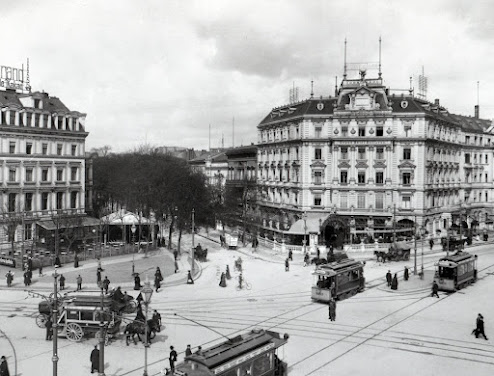Martin Bloch (1883-1954) was a German artist. Influential as a colourist and teacher, his paintings: dynamic still lifes, landscapes, and cityscapes, often with figures, are found in public and private collections in Britain, America, Europe and Israel.
From https://martinbloch.org/:
Bloch was born in November 1883 in Neisse, then a German town in Upper Silesia, now Nysa, Poland. Although the family was Jewish, Bloch and his brother attended a Catholic Gymnasium. Hoping to become an artist, and unwilling to enter the family lace-making business, Bloch moved to Berlin in 1902. Initially he studied architecture, then aesthetics with Heinrich Wolfflin in Munich. By 1907 he was back in Berlin, taking drawing classes with Lovis Corinth, a leading member of the Berlin Secession. In 1912 he was living and painting in Paris, centre of European Modernism.
 |
In Malaga 1915-16
|
In 1914 Bloch travelled to the South of France, and then Spain, where he lived until 1919. He painted, met up with avant-garde French artists Sonia and Robert Delauny and Marie Laurencin, and studied old masters in the Prado with his future brother-in-law, Helmut Ruhemann. Following his return to Berlin, he held his first major solo exhibition at the Paul Cassirer Gallery in 1920, and married journalist and theatre critic Charlotte Zavrel (née Ruhemann); their daughter, Barbara, was born in 1922. From 1926 he ran a private art school, first with expressionist painter Anton Kerschbaumer, and then, from 1931, with Karl Schmidt-Rottluff, one of the founders of Die Brücke group. From 1924 to 1930 Bloch, his family and students, spent several months every summer in Italy painting by the shores of Lake Garda.
In 1933 as secretary of the Berlin Riechsverbandes bildeneder Kunstler Deutschlands (a professional association for fine artists in Weimar Germany) Bloch was responsible for hanging their annual show. When SA guards under the pro-Nazi Prince August Wilhelm forced entry and removed paintings, Bloch felt directly threatened. The Bloch family fled Nazi Germany in 1934 via Denmark, where they stayed with the Danish writer Karin Michaelis in Thurø alongside other refugees including Bertholt Brecht and Walter Benjamin. They reached London and Bloch opened an art school: the School of Contemporary Painting and Drawing with Australian painter Roy de Maistre in October 1934. His first major London exhibition was held in the spring of 1939 at the Reid and Lefevre Gallery, but by September 1939 England was at war, and, in 1940, Bloch was interned as an enemy alien, first in Huyton camp and then in Sefton on the Isle of Man. Released in 1941, Bloch returned to London where he drew and painted the bombed city and volunteered as a fire-watcher for the Home Guard.
In 1947 Bloch became a British citizen. During the post-war years he painted the English countryside, visited America in 1948, and worked extensively in Wales, staying with his friend and fellow artist, Joseph Herman in Ystradginlais. The Ben Uri Gallery held a joint exhibition of their work in 1949, and both artists contributed large paintings of Welsh miners to the seminal Festival of Britain exhibition 60 Paintings for 51. Between 1949 and his death in London in June 1954, Bloch taught at Camberwell school of Art, where he influenced a new generation of British painters.

|
|
 |
Fehrbellinerplatz Berlin 1933
|
 |
| 1931 |
 |
Thunderstorm approaching 1930
|

















